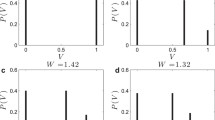Abstract
The background activity of a cortical neural network is modeled by a homogeneous integrate-and-fire network with unreliable inhibitory synapses. For the case of fast synapses, numerical and analytical calculations show that the network relaxes into a stationary state of high attention. The majority of the neurons has a membrane potential just below the threshold; as a consequence the network can react immediately – on the time scale of synaptic transmission- on external pulses. The neurons fire with a low rate and with a broad distribution of interspike intervals. Firing events of the total network are correlated over short time periods. The firing rate increases linearly with external stimuli. In the limit of infinitely large networks, the synaptic noise decreases to zero. Nevertheless, the distribution of interspike intervals remains broad.
Similar content being viewed by others
References
Abbott, L. F., & Van Vreeswijk, C. (1993). Asynchronous states in networks of pulse-coupled oscillators. Physical Review E, 48, 1483–1490.
Abeles, M. (1991). Corticonics. Cambridge: Cambridge University Press.
Allen, C., & Stevens, C. F. (1994). An evaluation of causes for unreliability of synaptic transmission. Proceedings of the National Academy of Sciences of the United States of America, 91, 10380–10383.
Aviel, Y., Horn, D., Abeles, M. (2005). Memory capacity of balanced networks. Neural Computation, 17, 691–713.
Aviel, Y., Mehring, Abeles, M., & Horn, D. (2003). On embedding synfire chains in a balanced network. Neural Computation, 15(6), 1321–1340.
Brunel, N. (2000). Dynamics of sparsely connected networks of excitatory and inhibitory spiking neurons. Journal of Computational Neuroscience, 8, 183–208.
Brunel, N., & Hakim, V. (1999). Fast global oscillations in networks of integrate-and-fire neurons with low firing rates. Neural Computation, 11, 1621–1671.
Ernst, U., Pawelzik, K., & Geisel, T. (1995). Synchronization induced by temporal delays in pulse-coupled oscillators. Physical Review Letters, 74, 1570–1574.
Gerstner, W., & Kistler, W. (2002). Spiking Neuron Models. Cambridge: Cambridge University Press.
Hansel, D., Mato, G., & Meunier, C. (1993). Clustering and slow switching in globally coupled phase oscillators. Physical Review, E48, 3470–3477.
Hertz, J. A., Richmond, B. J., & Nilsen, K. (2003). Anomalous response variability in a balanced cortical network. Neurocomputers, 52–54, 787–792.
Kestler, J., & Kinzel, W. (2006). Multifractal distribution of spike intervals for two neurons coupled by unreliable pulses. Journal of Physics A, 39, L461–L466.
Lisman, J. E. (1997). Bursts as a unit of neural information: Making unreliable synapses reliable. Trends in Neurosciences, 20, 38–43.
Mirollo, R. E., & Strogatz, S. H. (1990). SIAM Journal of Applied Mathematics, 50, 1645.
Shadlen, M. N., & Newsome, W. T. (1994). Noise, neural codes and cortical organization. Current Opinion in Neurobiology 4(4), 569–579.
Strogatz, S. H. (2001). Nonlinear dynamics and chaos. Cambridge: Cambridge University Press.
Timme, M., Wolf, F., & Geisel, T. (2002). Coexistence of regular and irregular dynamics in complex networks of pulse-coupled oscillators. Physical Review Letters, 89, 258701.
Trevelyan, A. J., & Watkinson, O. (2005). Does inhibition balance excitation in neocortex? Progress in Biophysics and Molecular Biology, 87, 109–143.
Tuckwell, H. C. (1998). Introduction to theoretical neurobiology. Cambridge: Cambridge University Press.
Van Vreeswijk, C. (1996). Partial synchronization in populations of pulse-coupled oscillators. Physical Review E, 54, 5522–5537.
Van Vreeswijk, C., & Sompolinsky, H. (1996). Chaos in neuronal networks with balanced excitatory and inhibitory activity. Science, 274, 1724–1726.
Zillmer, R., Livi, R., Politi, A., & Torcini, A. (2006). Desynchronization in diluted neural networks. Physical Review E, 74, 036203.
Author information
Authors and Affiliations
Corresponding author
Additional information
Action Editor: Misha Tsodyks
Rights and permissions
About this article
Cite this article
Kinzel, W. On the stationary state of a network of inhibitory spiking neurons. J Comput Neurosci 24, 105–112 (2008). https://doi.org/10.1007/s10827-007-0049-3
Received:
Revised:
Accepted:
Published:
Issue Date:
DOI: https://doi.org/10.1007/s10827-007-0049-3




